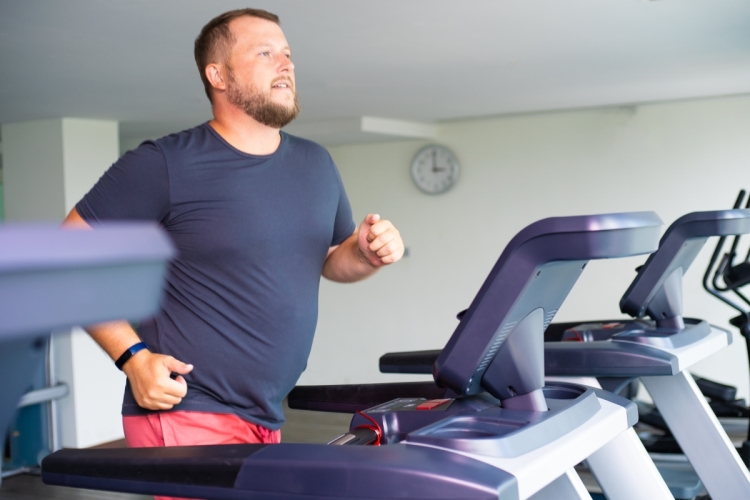Ketosis and Exogenous Ketones: The Key to Unlocking More Energy
Written by Stephen Anton PhD on January, 30th 2022

We have all likely heard the phrase ketosis mentioned before, but what it exactly means may not be crystal clear. Technically, ketosis is the metabolic state that occurs when the blood has a high concentration of ketones. In this state, which is distinct from the unhealthy state of ketoacidosis, ketones become an important source of energy for both the mind and body.
Ketones are a class of acidic organic compounds that includes acetone and aceto-acetic acid. They serve as an alternative fuel source for the body when glucose levels are in short supply. In the past, it was thought that having ketones in the blood was not healthy, but we now know that having ketones in the blood can have many beneficial health effects.
Benefits of Ketones/Ketosis
One of the major benefits of using ketones for energy (or being in a state of ketosis) is that the body becomes more metabolically efficient. This means that it produces higher amounts of energy (ATP) and simultaneously lower amounts of metabolic wastes. This is because ketones are a “cleaner” energy source than glucose and thus using ketones for energy should result in less oxidative stress or wear and tear for the body.
Sadly, most people have never experienced what this healthy metabolic state feels like. This is largely because their metabolic systems have become dysregulated from living unhealthy lifestyles, including frequent consumption of unhealthy foods combined with little movement throughout the day. This can result in a roller coaster energy effect, where energy drops when food is not consumed driving people to eat frequently throughout the day. Over time, frequent food consumption can dysregulate metabolism and increase risk for metabolic disease conditions such as Type 2 diabetes.
Lifestyle Changes Can Activate Ketosis But Are Difficult to Sustain
The good news is that it is possible to achieve the metabolic state of ketosis through lifestyle changes alone, specifically long fasts or the ketogenic diet. But the bad news is that these lifestyle changes are quite challenging and not appealing for most people to do consistently over the long-term.
Combining Lifestyle Habits Gets Us on the Path to Ketosis
Of course, some lifestyle changes, such as intermittent fasting or time restricted eating and regularly exercising are relatively easy to sustain and can help shift the body towards using ketones as a source of energy. However, these changes may not produce a full-blown state of ketosis.
For these reasons, I recommend adopting as many of the lifestyle habits (described below) as possible.
Exogenous Ketones Complement the Ketogenic Lifestyle
The more lifestyle habits one can adapt, the closer one will be to experiencing ketosis when they take exogenous ketones. Thus, exogenous ketones have the potential to complement an otherwise healthy lifestyle and help healthy individuals shift into a state of ketosis even if they are not following a strict ketogenic diet. When in this state, one is much less likely to consume or be tempted by unhealthy foods such as high sugar carbohydrates, and much more likely to feel like exercising.
In other words, the exogenous ketones and ketogenic lifestyle can have a symbiotic relationship; the exogenous ketones can encourage a ketogenic lifestyle, and a ketogenic lifestyle can amplify and extend the effects of exogenous ketones.
For this reason, the exogenous ketones can help provide a solution to the roller coaster energy most people experience from frequent food consumption during the day.
Ketones Produce a New Experience
For the majority of people, exogenous ketones will provide an experience they’ve never had before, what it feels like to be in a state of ketosis. This means that they would likely experience metabolic benefits of greater energy production than ever before. Most people have forgotten what it’s like to feel good, focused, and energized.
Does this mean one should lead an indulgent lifestyle and eat whatever they want with reckless abandon? Absolutely not. The more dysregulated one’s metabolic system is, the more challenging it will be for the ketones to put them into a state of ketosis or to shift their metabolic state towards ketone production/utilization.
How Long Will I Feel the Effects of Exogenous Ketones
Exogenous ketones have the ability to put the body into a state of ketosis within an hour and some within a few minutes. The time it takes will vary by what the person has done before or after. And the effects generally last anywhere between two to four hours, but this will also vary by what the person does after consuming the ketones.
Benefits and Potential Side Effects of Exogenous Ketones
For anyone interested in this experience or experiencing what ketosis feels like, the exogenous ketones are definitely worth considering.[1] We now have scientific evidence that exogenous ketones can lower blood glucose, enhance cognitive and physical function, support fat loss, and reduce inflammation [2][3] in a manner similar to that achieved through lifestyle changes. In some cases, the effects in terms of ketone levels are likely to be greater.
Do all of these potential benefits mean that everyone should take exogenous ketones? Not necessarily.
Although exogenous ketones are generally considered well tolerated, [4] some people have reported experiencing gastrointestinal issues, such as nausea or diarrhea, after taking them. Others may feel “too much” energy. Although this is not necessary a bad thing, it may feel uncomfortable at first.
For both of these scenarios, the solution is generally to reduce the dosage and or to consume the ketones at a slower rate. [5] Over time, most people will feel more comfortable shifting in and out of metabolic states, in which they utilize ketones instead of glucose for energy. That said, not everyone will respond the same way to exogenous ketones and so it’s important to determine if the benefits outweigh any potential negative effects.
Dr. Anton’s Ketone Routine
Personally, I like to take one pack after my first meal, which typically occurs around 12pm, and a second packet with my late afternoon workout which typically is my hardest workout of the day. I find that when I combine the ketones with a ketogenic lifestyle in this manner, I stay in the zone and feel sharp and energized all day long.
Of course, the type of ketones matter. If you would like more information on the specific product I recommend, please message me.
More on intermittent fasting:
Ketosis and Exogenous Ketones: The Key to Unlocking More Energy
Written by Stephen Anton PhD on January, 30th 2022

We have all likely heard the phrase ketosis mentioned before, but what it exactly means may not be crystal clear. Technically, ketosis is the metabolic state that occurs when the blood has a high concentration of ketones. In this state, which is distinct from the unhealthy state of ketoacidosis, ketones become an important source of energy for both the mind and body.
Ketones are a class of acidic organic compounds that includes acetone and aceto-acetic acid. They serve as an alternative fuel source for the body when glucose levels are in short supply. In the past, it was thought that having ketones in the blood was not healthy, but we now know that having ketones in the blood can have many beneficial health effects.
Benefits of Ketones/Ketosis
One of the major benefits of using ketones for energy (or being in a state of ketosis) is that the body becomes more metabolically efficient. This means that it produces higher amounts of energy (ATP) and simultaneously lower amounts of metabolic wastes. This is because ketones are a “cleaner” energy source than glucose and thus using ketones for energy should result in less oxidative stress or wear and tear for the body.
Sadly, most people have never experienced what this healthy metabolic state feels like. This is largely because their metabolic systems have become dysregulated from living unhealthy lifestyles, including frequent consumption of unhealthy foods combined with little movement throughout the day. This can result in a roller coaster energy effect, where energy drops when food is not consumed driving people to eat frequently throughout the day. Over time, frequent food consumption can dysregulate metabolism and increase risk for metabolic disease conditions such as Type 2 diabetes.
Lifestyle Changes Can Activate Ketosis But Are Difficult to Sustain
The good news is that it is possible to achieve the metabolic state of ketosis through lifestyle changes alone, specifically long fasts or the ketogenic diet. But the bad news is that these lifestyle changes are quite challenging and not appealing for most people to do consistently over the long-term.
Combining Lifestyle Habits Gets Us on the Path to Ketosis
Of course, some lifestyle changes, such as intermittent fasting or time restricted eating and regularly exercising are relatively easy to sustain and can help shift the body towards using ketones as a source of energy. However, these changes may not produce a full-blown state of ketosis.
For these reasons, I recommend adopting as many of the lifestyle habits (described below) as possible.
Exogenous Ketones Complement the Ketogenic Lifestyle
The more lifestyle habits one can adapt, the closer one will be to experiencing ketosis when they take exogenous ketones. Thus, exogenous ketones have the potential to complement an otherwise healthy lifestyle and help healthy individuals shift into a state of ketosis even if they are not following a strict ketogenic diet. When in this state, one is much less likely to consume or be tempted by unhealthy foods such as high sugar carbohydrates, and much more likely to feel like exercising.
In other words, the exogenous ketones and ketogenic lifestyle can have a symbiotic relationship; the exogenous ketones can encourage a ketogenic lifestyle, and a ketogenic lifestyle can amplify and extend the effects of exogenous ketones.
For this reason, the exogenous ketones can help provide a solution to the roller coaster energy most people experience from frequent food consumption during the day.
Ketones Produce a New Experience
For the majority of people, exogenous ketones will provide an experience they’ve never had before, what it feels like to be in a state of ketosis. This means that they would likely experience metabolic benefits of greater energy production than ever before. Most people have forgotten what it’s like to feel good, focused, and energized.
Does this mean one should lead an indulgent lifestyle and eat whatever they want with reckless abandon? Absolutely not. The more dysregulated one’s metabolic system is, the more challenging it will be for the ketones to put them into a state of ketosis or to shift their metabolic state towards ketone production/utilization.
How Long Will I Feel the Effects of Exogenous Ketones
Exogenous ketones have the ability to put the body into a state of ketosis within an hour and some within a few minutes. The time it takes will vary by what the person has done before or after. And the effects generally last anywhere between two to four hours, but this will also vary by what the person does after consuming the ketones.
Benefits and Potential Side Effects of Exogenous Ketones
For anyone interested in this experience or experiencing what ketosis feels like, the exogenous ketones are definitely worth considering.[1] We now have scientific evidence that exogenous ketones can lower blood glucose, enhance cognitive and physical function, support fat loss, and reduce inflammation [2][3] in a manner similar to that achieved through lifestyle changes. In some cases, the effects in terms of ketone levels are likely to be greater.
Do all of these potential benefits mean that everyone should take exogenous ketones? Not necessarily.
Although exogenous ketones are generally considered well tolerated, [4] some people have reported experiencing gastrointestinal issues, such as nausea or diarrhea, after taking them. Others may feel “too much” energy. Although this is not necessary a bad thing, it may feel uncomfortable at first.
For both of these scenarios, the solution is generally to reduce the dosage and or to consume the ketones at a slower rate. [5] Over time, most people will feel more comfortable shifting in and out of metabolic states, in which they utilize ketones instead of glucose for energy. That said, not everyone will respond the same way to exogenous ketones and so it’s important to determine if the benefits outweigh any potential negative effects.
Dr. Anton’s Ketone Routine
Personally, I like to take one pack after my first meal, which typically occurs around 12pm, and a second packet with my late afternoon workout which typically is my hardest workout of the day. I find that when I combine the ketones with a ketogenic lifestyle in this manner, I stay in the zone and feel sharp and energized all day long.
Of course, the type of ketones matter. If you would like more information on the specific product I recommend, please message me.
More on intermittent fasting:

Get the Beginner’s Guide to Intermittent Fasting
Take advantage of this FREE PDF and learn the basics of intermittent fasting.

Get the Beginner’s Guide to Intermittent Fasting
Take advantage of this 100% free PDF and learn the basics of intermittent fasting.

Get the Beginner’s Guide to Intermittent Fasting
Take advantage of this FREE PDF and learn the basics of intermittent fasting.









